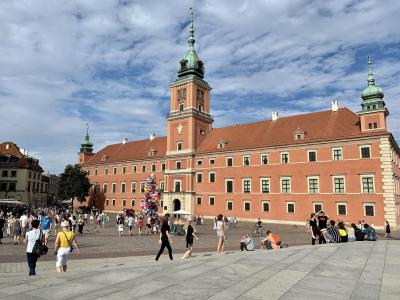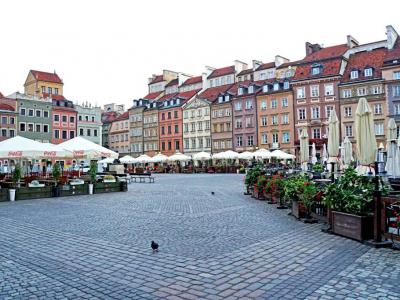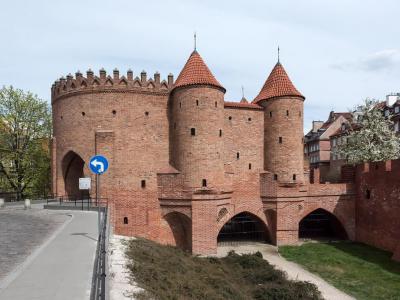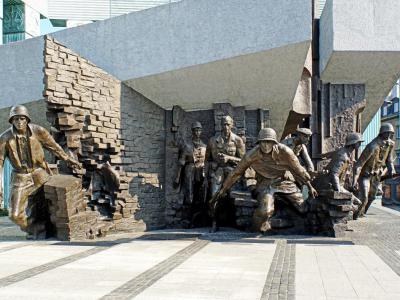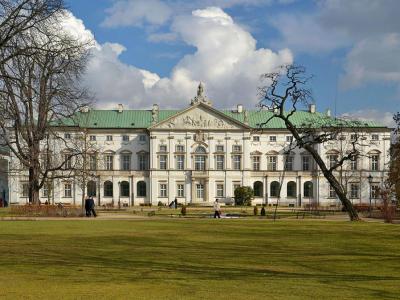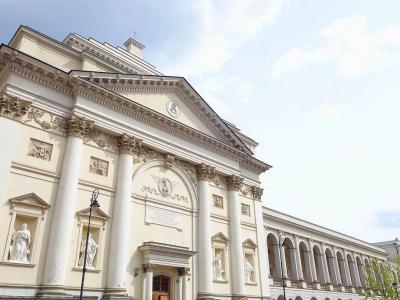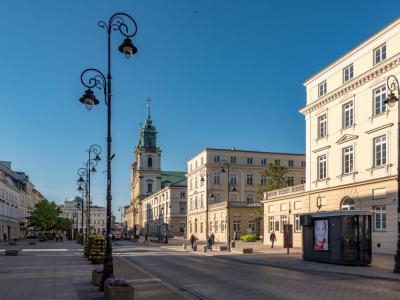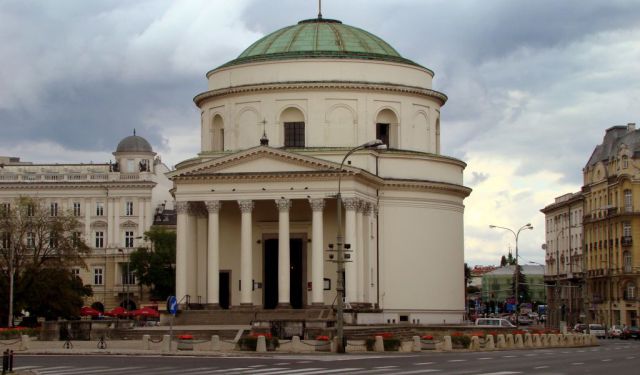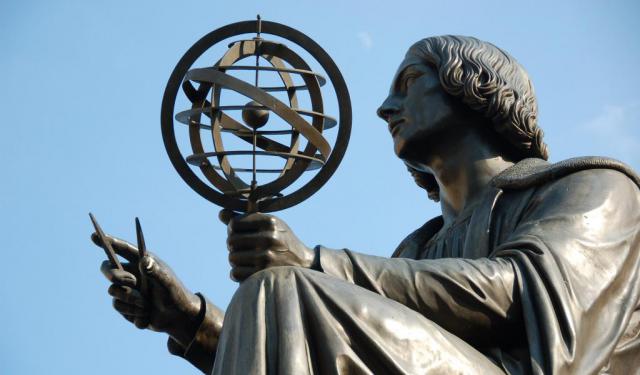Warsaw Introduction Walking Tour (Self Guided), Warsaw
Warsaw rose to prominence when King Sigismund III moved the nation’s capital from Krakow in the 16th century. The city was widely known as the “Paris of the North” thanks to the beautiful boulevards lined with grand architecture. The center of the city is called Old Town, and it has many historic buildings like the Royal Castle on Castle Square and the Presidential Palace. Old Town is a UNESCO World Heritage Site.
The Second World War left 85 percent of Warsaw’s buildings destroyed. The city earned the name “Phoenix City” as it rose from the ashes after the war, working hard to restore the city to its pre-war glory. As you wander the town, keep in mind that nearly everything you see had to be rebuilt. To learn more about the war and the battles fought here, head over to the Warsaw Uprising Monument and Warsaw Rising Museum.
The city welcomes visitors, and it’s often ranked as one of the best places to live and the most business-friendly cities in the world. There’s always something to see and do in Warsaw. Start your day by touring the Royal Castle and visiting Market Square. Follow the Royal Route south through town. It connects the city with King Jan III’s home at Winalow. Along the way, take a break to admire Lazienki Park and the many monuments and palaces you pass.
Today, Warsaw is a vibrant city full of history, culture, and a do-anything attitude. See the best sights in Warsaw - take this self-guided walking tour through the Polish capital and the seventh-largest city in the European Union.
The Second World War left 85 percent of Warsaw’s buildings destroyed. The city earned the name “Phoenix City” as it rose from the ashes after the war, working hard to restore the city to its pre-war glory. As you wander the town, keep in mind that nearly everything you see had to be rebuilt. To learn more about the war and the battles fought here, head over to the Warsaw Uprising Monument and Warsaw Rising Museum.
The city welcomes visitors, and it’s often ranked as one of the best places to live and the most business-friendly cities in the world. There’s always something to see and do in Warsaw. Start your day by touring the Royal Castle and visiting Market Square. Follow the Royal Route south through town. It connects the city with King Jan III’s home at Winalow. Along the way, take a break to admire Lazienki Park and the many monuments and palaces you pass.
Today, Warsaw is a vibrant city full of history, culture, and a do-anything attitude. See the best sights in Warsaw - take this self-guided walking tour through the Polish capital and the seventh-largest city in the European Union.
How it works: Download the app "GPSmyCity: Walks in 1K+ Cities" from Apple App Store or Google Play Store to your mobile phone or tablet. The app turns your mobile device into a personal tour guide and its built-in GPS navigation functions guide you from one tour stop to next. The app works offline, so no data plan is needed when traveling abroad.
Warsaw Introduction Walking Tour Map
Guide Name: Warsaw Introduction Walking Tour
Guide Location: Poland » Warsaw (See other walking tours in Warsaw)
Guide Type: Self-guided Walking Tour (Sightseeing)
# of Attractions: 9
Tour Duration: 2 Hour(s)
Travel Distance: 2.5 Km or 1.6 Miles
Author: leticia
Sight(s) Featured in This Guide:
Guide Location: Poland » Warsaw (See other walking tours in Warsaw)
Guide Type: Self-guided Walking Tour (Sightseeing)
# of Attractions: 9
Tour Duration: 2 Hour(s)
Travel Distance: 2.5 Km or 1.6 Miles
Author: leticia
Sight(s) Featured in This Guide:
- Castle Square (Plac Zamkowy)
- Royal Castle
- Old Town Market Place (Rynek Starego Miasta)
- Warsaw Barbican (Barbakan warszawski)
- Monument to the Warsaw Uprising Fighters
- Krasiński Palace
- St. Anne's Church
- Presidential Palace
- Royal Route
1) Castle Square (Plac Zamkowy) (must see)
Located in the middle of Old Town, this square was first built in 1821. It's roughly triangular, with one side facing the Royal Castle.
One of the most prominent features of the square is Sigismund's Column, a 17th-century monument to King Sigismund III. It was built in 1644 and is the world's oldest secular column built in modern history. It's a landmark that you can't miss.
One of Warsaw's biggest highways runs underneath Castle Square. Besides the castle, the rest of the square is surrounded by historic townhouses. This is the center of exploration in Warsaw-it's a meeting point for locals and tourists alike, and it's full of life. There are street musicians, horse carriages, churches, and restaurants all around. The main attraction here, though, is the Royal Castle.
Castle Square also marks the northern point of the Royal Route, which led from the castle southward to King Jan III Sobieski's personal residence at Wilanów. Along that route, you'll pass many must-see Warsaw sights.
One of the most prominent features of the square is Sigismund's Column, a 17th-century monument to King Sigismund III. It was built in 1644 and is the world's oldest secular column built in modern history. It's a landmark that you can't miss.
One of Warsaw's biggest highways runs underneath Castle Square. Besides the castle, the rest of the square is surrounded by historic townhouses. This is the center of exploration in Warsaw-it's a meeting point for locals and tourists alike, and it's full of life. There are street musicians, horse carriages, churches, and restaurants all around. The main attraction here, though, is the Royal Castle.
Castle Square also marks the northern point of the Royal Route, which led from the castle southward to King Jan III Sobieski's personal residence at Wilanów. Along that route, you'll pass many must-see Warsaw sights.
2) Royal Castle (must see)
The Royal Castle as it stands today was rebuilt and restored in the late 1970s and early 1980s. The Germans had destroyed it during World War II, but the foundation and many components were rescued and used in the reconstruction.
The original structure was built in the Middle Ages. Sometime around 1410, the first parts of the Curia Maior, or Big Manor, were built. It functioned as a prince manor. When Masovia was incorporated into the Kingdom of Poland in 1526, the building became a royal residence. Between 1569 and 1572, King Sigismund II Augustus began altering the structure to accommodate the new parliament. Next to Curia Maior, the king built a Renaissance-style building known as Royal House, where he resided when parliament was in session. Over the years, the castle continued to expand.
The castle was destroyed during The Deluge from 1655 to 1657 when Sweden and Russia invaded. Reconstruction began in 1657, but the royal purse was stretched, so construction was limited to rebuilding what had already been there.
Why You Should Visit:
The castle operates as a museum while also being the setting of state functions. Inside the castle, you'll see one of the most impressive art collections in Europe.
The Jagiellonian Rooms contain the modern Gallery of Painting, Sculpture, and Decorative Arts. The Houses of Parliament, where the world's second-oldest constitution was signed into effect, is available to be toured. The Royal Apartments provide a glimpse into the lavish lifestyles of the royal families and the chance to view many masterpieces from the 1700s. The Lanckoronski Collection includes two Rembrandts and a Stradivari violin.
The castle, together with Old Town Warsaw, is a UNESCO World Heritage Site.
The original structure was built in the Middle Ages. Sometime around 1410, the first parts of the Curia Maior, or Big Manor, were built. It functioned as a prince manor. When Masovia was incorporated into the Kingdom of Poland in 1526, the building became a royal residence. Between 1569 and 1572, King Sigismund II Augustus began altering the structure to accommodate the new parliament. Next to Curia Maior, the king built a Renaissance-style building known as Royal House, where he resided when parliament was in session. Over the years, the castle continued to expand.
The castle was destroyed during The Deluge from 1655 to 1657 when Sweden and Russia invaded. Reconstruction began in 1657, but the royal purse was stretched, so construction was limited to rebuilding what had already been there.
Why You Should Visit:
The castle operates as a museum while also being the setting of state functions. Inside the castle, you'll see one of the most impressive art collections in Europe.
The Jagiellonian Rooms contain the modern Gallery of Painting, Sculpture, and Decorative Arts. The Houses of Parliament, where the world's second-oldest constitution was signed into effect, is available to be toured. The Royal Apartments provide a glimpse into the lavish lifestyles of the royal families and the chance to view many masterpieces from the 1700s. The Lanckoronski Collection includes two Rembrandts and a Stradivari violin.
The castle, together with Old Town Warsaw, is a UNESCO World Heritage Site.
3) Old Town Market Place (Rynek Starego Miasta) (must see)
In the very center of Old Town Warsaw, you'll find the Old Town Market Place. Since the city was founded in the 13th century, merchants would meet here to sell their goods. The square has been the center of Warsaw life since, with everything from festivals to executions occurring here.
The townhouses built around the Old Town Market Place were Gothic until a fire destroyed them in 1607. Renaissance-style buildings replaced them, only to be replaced by the current late-Baroque style that you see today. There was a large town hall building here, but the German Luftwaffe destroyed it and the rest of the square during World War II.
The square was rebuilt in the 1950s, and efforts were taken to mimic its appearance from the 17th century. Each side of the square is named to an 18th-century parliamentarian. Dekert's Side on the north is named for Jan Dekert, a merchant and political activist. Barss' Side contains the Adam Mickiewicz Museum, honoring its namesake's poetry. Kollataj's Side honors Hugo Stumberg Kołłataj’s, a constitutional reformer and educationalist, while Zakrzewski's Side is named for mayor of Warsaw, nobleman, and art collector Ignacy Wyssogota Zakrzewski.
Several of the buildings on the square house the Warsaw Museum. Here, you can see collections of historical artifacts from the city that depict daily life. Their collection includes more than 300,000 objects spread over 21 themed rooms. The main entrance is in house No. 42 on Dekert's Side.
In the square, you will also see a statue of Syrenka, the "little mermaid" of Warsaw. She has appeared on the city's official coat of arms since at least the 14th century. The statue has stood here since 1855.
The townhouses built around the Old Town Market Place were Gothic until a fire destroyed them in 1607. Renaissance-style buildings replaced them, only to be replaced by the current late-Baroque style that you see today. There was a large town hall building here, but the German Luftwaffe destroyed it and the rest of the square during World War II.
The square was rebuilt in the 1950s, and efforts were taken to mimic its appearance from the 17th century. Each side of the square is named to an 18th-century parliamentarian. Dekert's Side on the north is named for Jan Dekert, a merchant and political activist. Barss' Side contains the Adam Mickiewicz Museum, honoring its namesake's poetry. Kollataj's Side honors Hugo Stumberg Kołłataj’s, a constitutional reformer and educationalist, while Zakrzewski's Side is named for mayor of Warsaw, nobleman, and art collector Ignacy Wyssogota Zakrzewski.
Several of the buildings on the square house the Warsaw Museum. Here, you can see collections of historical artifacts from the city that depict daily life. Their collection includes more than 300,000 objects spread over 21 themed rooms. The main entrance is in house No. 42 on Dekert's Side.
In the square, you will also see a statue of Syrenka, the "little mermaid" of Warsaw. She has appeared on the city's official coat of arms since at least the 14th century. The statue has stood here since 1855.
4) Warsaw Barbican (Barbakan warszawski)
The Warsaw Barbican is one of the last remaining relics of the extensive network of walls, fortifications, and gates that once surrounded the city. It was built in 1540 and designed by Italian Renaissance architect Jan Baptist the Venetian. It replaced a gate on Nowomiejska Street.
In the 16th century, while Jan Baptist was living and working in Mazovia, the city's 14th-century walls were in disrepair. The barbican was part of his revitalization project. It took shape as a three-level semicircular bastion that was 14 meters wide and 15 meters tall. There was also a 30-meter-wide moat around the outside of the city walls.
Unfortunately, by the time the barbican was completed, it had become obsolete. Artillery technology had advanced considerably. It was used for its designed defensive purpose only once during the Swedish Invasion in 1656. Over the following years, the barbican was partially dismantled and modified to allow for a larger gate into the city. In the 1800s, part of the structure was incorporated into new apartment buildings.
Like many other Warsaw buildings, the barbican was more or less destroyed during World War II. It was rebuilt in the 1950s from 17th-century etchings. The Museum of Warsaw operates The Barbican. For more information about the history of the city, visit them in Old Town Market Place.
In the 16th century, while Jan Baptist was living and working in Mazovia, the city's 14th-century walls were in disrepair. The barbican was part of his revitalization project. It took shape as a three-level semicircular bastion that was 14 meters wide and 15 meters tall. There was also a 30-meter-wide moat around the outside of the city walls.
Unfortunately, by the time the barbican was completed, it had become obsolete. Artillery technology had advanced considerably. It was used for its designed defensive purpose only once during the Swedish Invasion in 1656. Over the following years, the barbican was partially dismantled and modified to allow for a larger gate into the city. In the 1800s, part of the structure was incorporated into new apartment buildings.
Like many other Warsaw buildings, the barbican was more or less destroyed during World War II. It was rebuilt in the 1950s from 17th-century etchings. The Museum of Warsaw operates The Barbican. For more information about the history of the city, visit them in Old Town Market Place.
5) Monument to the Warsaw Uprising Fighters
The Warsaw Uprising was a pivotal moment in World War II for Poland. From August until October in 1944, the underground Polish resistance movement and the Home Army fought to retake Warsaw from the Germans. The uprising was timed to coincide with the German retreat from Poland as the Soviets advanced.
Being against the communist party, the resistance was not supported by the Soviet troops who stopped short of the town. Their pause allowed the Germans to regroup and defeat the uprising. In retaliation, the German troops destroyed virtually every building in Warsaw, spending the remainder of 1944 pillaging and looting the city before leaving it abandoned. The Soviets, who held their position outside of town and prevented Allied support from reaching Warsaw, only retook the town only after the Germans had left.
For many years after the war, the significance of the uprising was downplayed. Communist propaganda condemned the Home Army and their insurgent actions.
The monument to the tragic events was unveiled in 1989 on the 45th anniversary of the uprising. Wincenty Kucma and architect Jacek Budyn sculpted it. The monument is located just outside the Palace of Justice, the seat of the Polish Supreme Court.
If you'd like to learn a little more about the 1944 Uprising, don't miss the Warsaw Rising Museum. The museum's exhibits depict the fighting and everyday life during the uprising and cover the political issues and post-war Communist regime.
Being against the communist party, the resistance was not supported by the Soviet troops who stopped short of the town. Their pause allowed the Germans to regroup and defeat the uprising. In retaliation, the German troops destroyed virtually every building in Warsaw, spending the remainder of 1944 pillaging and looting the city before leaving it abandoned. The Soviets, who held their position outside of town and prevented Allied support from reaching Warsaw, only retook the town only after the Germans had left.
For many years after the war, the significance of the uprising was downplayed. Communist propaganda condemned the Home Army and their insurgent actions.
The monument to the tragic events was unveiled in 1989 on the 45th anniversary of the uprising. Wincenty Kucma and architect Jacek Budyn sculpted it. The monument is located just outside the Palace of Justice, the seat of the Polish Supreme Court.
If you'd like to learn a little more about the 1944 Uprising, don't miss the Warsaw Rising Museum. The museum's exhibits depict the fighting and everyday life during the uprising and cover the political issues and post-war Communist regime.
6) Krasiński Palace
Sometimes called the Palace of the Commonwealth, Krasiński Palace was built between 1677 and 1683 and reconstructed after World War II. It was initially designed and built for the Voivode of Plock, Jan Dobrogost Krasiński.
Krasiński came from an old Mazovian noble family. He was heir to a large fortune, and he was interested in French culture and architecture. He hired French artists for the work on his home, in addition to Michelangelo Palloni, who did the frescoes.
The palace was purchased by the state in 1765 and turned into the Treasury Commission and later the Supreme Court of Poland's home. It was burned down and mostly demolished during the German occupation of Poland during World War II. The Germans deliberately destroyed most of the artwork housed in the palace during the Warsaw Uprising; today, the collection contains only about five percent of its former catalog.
Today Krasiński Palace is part of the Polish National Library's Special Collections Section. The garden is a beautiful place to take a walk, look for the Baroque gate from Bohaterów Getta Street. The gardens are made up of a public park with fountains, walking paths, and many monuments. If you're visiting Krasiński Palace, take a detour across the street to visit the Warsaw Uprising Fighters monument.
Krasiński came from an old Mazovian noble family. He was heir to a large fortune, and he was interested in French culture and architecture. He hired French artists for the work on his home, in addition to Michelangelo Palloni, who did the frescoes.
The palace was purchased by the state in 1765 and turned into the Treasury Commission and later the Supreme Court of Poland's home. It was burned down and mostly demolished during the German occupation of Poland during World War II. The Germans deliberately destroyed most of the artwork housed in the palace during the Warsaw Uprising; today, the collection contains only about five percent of its former catalog.
Today Krasiński Palace is part of the Polish National Library's Special Collections Section. The garden is a beautiful place to take a walk, look for the Baroque gate from Bohaterów Getta Street. The gardens are made up of a public park with fountains, walking paths, and many monuments. If you're visiting Krasiński Palace, take a detour across the street to visit the Warsaw Uprising Fighters monument.
7) St. Anne's Church
The Neoclassical Saint Anne's Church is one of Warsaw's oldest buildings and most notable churches. Even though it has been rebuilt and reconstructed several times, its appearance has remained mostly unchanged since 1788.
The foundations were laid for the church back in 1454 when the Duchess of Masovia Anna Fiodorowna set it up for the Franciscan friars. In the 1700s, the facade was done in a Late-Baroque style. After suffering heavy damage in World War II, the church was restored between the late 1940s and 1970s.
The church impresses with its baroque style. It has a richly decorated interior that is full of beautiful frescoes. The only diamond vaulted ceiling is found here, in the cloister leading to the vestry. During the summer at noon, a 30 minutes organ concert is played every day except Sundays and holidays.
Inside the church, you will also find a simple wooden cross with an interesting history. The cross was built to commemorate the tragic loss of 96 lives in a 2010 Polish Air Force crash. The fatalities included the President of Poland, Lech Kaczyński, and his wife, Maria. The cross was displayed for a time at the Presidential Palace. However, the cross became a flashpoint in local politics, as it raised questions of the separation of church and state, religion, and Polish patriotism.
Why You Should Visit:
This church is completely painted from floor to ceiling with magnificent frescos. The illusions painted on the columns and walls are very beautiful.
Tip:
Try to schedule your visit around noon or 2pm to catch the daily organ concert (lasting 30 mins). It's also possible to climb to the top of the tower, which will earn you some impressive views over the city in a clear day.
The foundations were laid for the church back in 1454 when the Duchess of Masovia Anna Fiodorowna set it up for the Franciscan friars. In the 1700s, the facade was done in a Late-Baroque style. After suffering heavy damage in World War II, the church was restored between the late 1940s and 1970s.
The church impresses with its baroque style. It has a richly decorated interior that is full of beautiful frescoes. The only diamond vaulted ceiling is found here, in the cloister leading to the vestry. During the summer at noon, a 30 minutes organ concert is played every day except Sundays and holidays.
Inside the church, you will also find a simple wooden cross with an interesting history. The cross was built to commemorate the tragic loss of 96 lives in a 2010 Polish Air Force crash. The fatalities included the President of Poland, Lech Kaczyński, and his wife, Maria. The cross was displayed for a time at the Presidential Palace. However, the cross became a flashpoint in local politics, as it raised questions of the separation of church and state, religion, and Polish patriotism.
Why You Should Visit:
This church is completely painted from floor to ceiling with magnificent frescos. The illusions painted on the columns and walls are very beautiful.
Tip:
Try to schedule your visit around noon or 2pm to catch the daily organ concert (lasting 30 mins). It's also possible to climb to the top of the tower, which will earn you some impressive views over the city in a clear day.
8) Presidential Palace
Home to the Polish head of state, the Presidential Palace was built in 1643 as a home for local aristocrat Crown Great Hetman Stanislaw Koniecpolski. Koniecpolski owned so much of eastern Poland that he could cross the Commonwealth and spend each night in one of his own manors. The palace was designed by architect Constantino Tencalla, who also designed Sigismund's Column in Castle Square.
It's had several refurbishments since then. The current neoclassical style has been in place since 1818. Ever since then, it has served various government functions.
The first historical events occurred even earlier, though. In 1791, the home hosted the authors of the Constitution of May 3, 1791. That constitution was the first of its kind in Europe and the second of its kind in the world. In 1818, the house became the seat of the Viceroy. The council of ministers sat here between World Wars I and II. Since the German occupiers used the house, it survived World War II intact. After the war, the Warsaw Pact between the Soviet Union and the Eastern Bloc countries was signed here.
Since 1994, the palace has been the seat of the President of the Republic of Poland. As this is a functioning government building, visitors are not allowed inside, and the building is heavily guarded. But you can admire the impressive neoclassical facade from Nowy Street.
You'll also notice the large equestrian statue of Prince Jozef Poniatowski, created by Danish artist Bertel Thorvaldsen. The statue is modeled after a similar one of Roman Emperor Marcus Aurelius from Capitoline Hill in Rome. The original statue was destroyed during the Nazi occupation of Poland, and this recreation was made in 1950. It was based on Thorvaldsen's original models, donated from the Thorvaldsen Museum in Copenhagen.
It's had several refurbishments since then. The current neoclassical style has been in place since 1818. Ever since then, it has served various government functions.
The first historical events occurred even earlier, though. In 1791, the home hosted the authors of the Constitution of May 3, 1791. That constitution was the first of its kind in Europe and the second of its kind in the world. In 1818, the house became the seat of the Viceroy. The council of ministers sat here between World Wars I and II. Since the German occupiers used the house, it survived World War II intact. After the war, the Warsaw Pact between the Soviet Union and the Eastern Bloc countries was signed here.
Since 1994, the palace has been the seat of the President of the Republic of Poland. As this is a functioning government building, visitors are not allowed inside, and the building is heavily guarded. But you can admire the impressive neoclassical facade from Nowy Street.
You'll also notice the large equestrian statue of Prince Jozef Poniatowski, created by Danish artist Bertel Thorvaldsen. The statue is modeled after a similar one of Roman Emperor Marcus Aurelius from Capitoline Hill in Rome. The original statue was destroyed during the Nazi occupation of Poland, and this recreation was made in 1950. It was based on Thorvaldsen's original models, donated from the Thorvaldsen Museum in Copenhagen.
9) Royal Route (must see)
The Royal Route began as a communication route that led from the Royal Castle and Castle Square to King Jan III Sobieski's personal residence, known as Wilanów. The route runs through Old Town Warsaw, connecting many notable points and containing many monuments and sights.
The route spans south from Castle Square along Krakowskie Przedmieście Street, New World Street, Ujazdow Avenue, Belweder Street, and Sobieski Street. The route is named as an official historical monument in Poland.
The first part of the Royal Route, Krakowskie Przedmiescie, is one of Warsaw's best known and most prestigious streets. Around it, you will find many historical structures and sights. The north end of the road starts at the Presidential Palace and passes Warsaw University, the Polish Academy of Sciences. You'll also see Potocki Palace, Kazimierz Palace, Tyszkiewicz Palace, Czetwertyński Palace, Hotel Bristol, Saint Anne's Church, and Holy Cross Church.
Do not miss a stroll through the grounds of Lazienki Park. This 76-hectare park contains palaces, villas, monuments, and decorative structures. In the center of the park is the much-photographed Palace on the Isle. If you're in Warsaw during the summer, keep an ear out for the Sunday Chopin Concerts at the Fryderyk Chopin monument.
The Royal Route connects most of the must-see sights in Warsaw. Strolling the sidewalks here and taking your time to visit each monument, garden, and palace is well worth your time. There is much to explore and many quiet hidden treasures along the way.
One of the best-kept secrets is the summer residence of King Jan III Sobieski, known as Marysieńka. The palace is operated as a museum, with elaborate and authentic 17th, 18th, and 19th-century interiors throughout. It's also home to the Polish Portrait Gallery. The gardens are not to be missed. The house is often called the "Polish Versailles."
The route spans south from Castle Square along Krakowskie Przedmieście Street, New World Street, Ujazdow Avenue, Belweder Street, and Sobieski Street. The route is named as an official historical monument in Poland.
The first part of the Royal Route, Krakowskie Przedmiescie, is one of Warsaw's best known and most prestigious streets. Around it, you will find many historical structures and sights. The north end of the road starts at the Presidential Palace and passes Warsaw University, the Polish Academy of Sciences. You'll also see Potocki Palace, Kazimierz Palace, Tyszkiewicz Palace, Czetwertyński Palace, Hotel Bristol, Saint Anne's Church, and Holy Cross Church.
Do not miss a stroll through the grounds of Lazienki Park. This 76-hectare park contains palaces, villas, monuments, and decorative structures. In the center of the park is the much-photographed Palace on the Isle. If you're in Warsaw during the summer, keep an ear out for the Sunday Chopin Concerts at the Fryderyk Chopin monument.
The Royal Route connects most of the must-see sights in Warsaw. Strolling the sidewalks here and taking your time to visit each monument, garden, and palace is well worth your time. There is much to explore and many quiet hidden treasures along the way.
One of the best-kept secrets is the summer residence of King Jan III Sobieski, known as Marysieńka. The palace is operated as a museum, with elaborate and authentic 17th, 18th, and 19th-century interiors throughout. It's also home to the Polish Portrait Gallery. The gardens are not to be missed. The house is often called the "Polish Versailles."
Walking Tours in Warsaw, Poland
Create Your Own Walk in Warsaw
Creating your own self-guided walk in Warsaw is easy and fun. Choose the city attractions that you want to see and a walk route map will be created just for you. You can even set your hotel as the start point of the walk.
Jewish Warsaw Walking Tour
Once abundant, the Jewish population of Warsaw has left a profound mark on the city. Nowadays, walking along the peaceful streets of Poland's capital it is hard to imagine that thousands of Jews were once herded here and forced into cattle cars to meet their end in the Nazi concentration camps during World War II.
At the heart of this tragic chapter in Warsaw's Jewish history lies the... view more
Tour Duration: 2 Hour(s)
Travel Distance: 4.7 Km or 2.9 Miles
At the heart of this tragic chapter in Warsaw's Jewish history lies the... view more
Tour Duration: 2 Hour(s)
Travel Distance: 4.7 Km or 2.9 Miles
Praga District Walking Tour
Praga – not to be confused with the neighboring Czech Republic's capital city – is an old, yet vibrant district on the eastern bank of the Vistula River in Warsaw. For many years overshadowed by its more famous counterpart, Warsaw's Old Town, the area used to be off-limits for Western travelers due to its high crime rate. Recently, however, thanks to the lavish influx of investment,... view more
Tour Duration: 1 Hour(s)
Travel Distance: 2.1 Km or 1.3 Miles
Tour Duration: 1 Hour(s)
Travel Distance: 2.1 Km or 1.3 Miles
Warsaw's Historical Churches
Given that Poland is one of the most religious countries in Europe – with Roman Catholicism being the dominant faith here since the Baptism of Poland in 966, – it is not at all surprising that Warsaw is home to many centuries-old churches and cathedrals. While reflecting the city's deep-rooted religious and cultural heritage, some of these historical temples are also magnificent... view more
Tour Duration: 1 Hour(s)
Travel Distance: 1.4 Km or 0.9 Miles
Tour Duration: 1 Hour(s)
Travel Distance: 1.4 Km or 0.9 Miles
Monuments and Statues
The capital city of a proud nation such as Poland, Warsaw is abundant with monuments of various sorts, dedicated to celebrated personalities and those who made a mark in the history of the country.
Some of these landmarks serve as reminders of the city's resilience and the enduring spirit of its people. Among them are the Jan Kiliński Monument commemorating a hero of the 1794 Kosciuszko... view more
Tour Duration: 2 Hour(s)
Travel Distance: 2.9 Km or 1.8 Miles
Some of these landmarks serve as reminders of the city's resilience and the enduring spirit of its people. Among them are the Jan Kiliński Monument commemorating a hero of the 1794 Kosciuszko... view more
Tour Duration: 2 Hour(s)
Travel Distance: 2.9 Km or 1.8 Miles
Useful Travel Guides for Planning Your Trip
15 Distinctively Polish Things to Buy in Warsaw
A country with a great deal of taste and turbulent history, Poland has a lot to offer those with the eyes to see and mouth to savor. And Warsaw is, perhaps, the best place to find all things Polish brought together. Here's the list of the most distinctive Polish goods, caringly drawn by a...
The Most Popular Cities
/ view all




